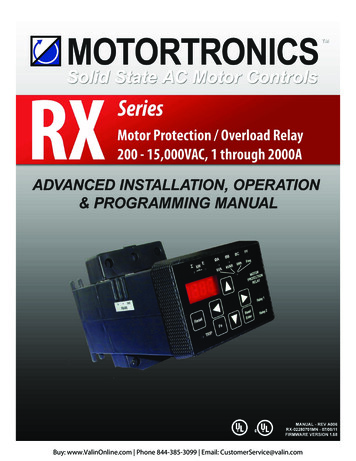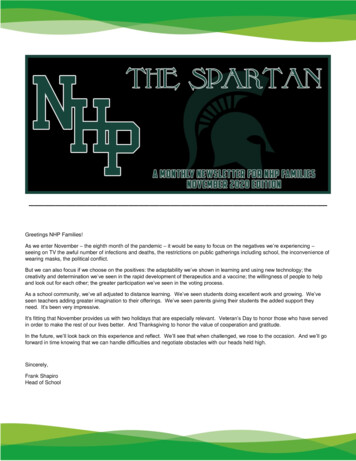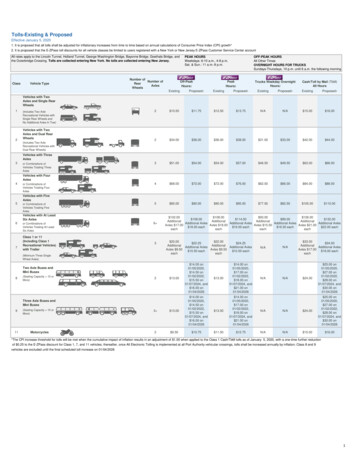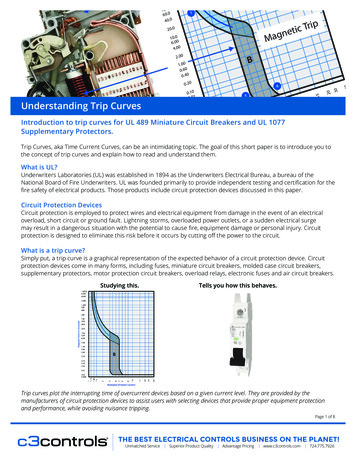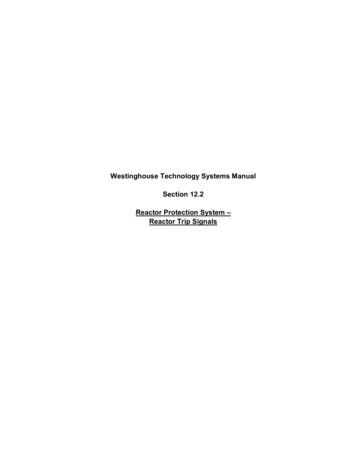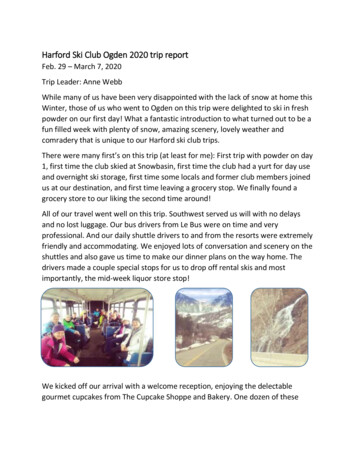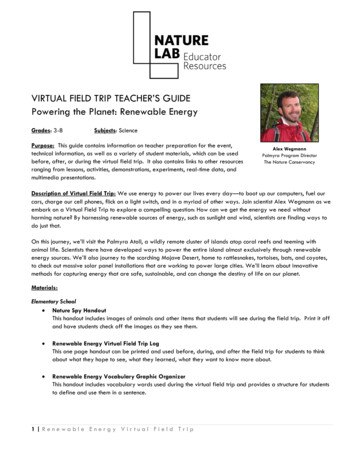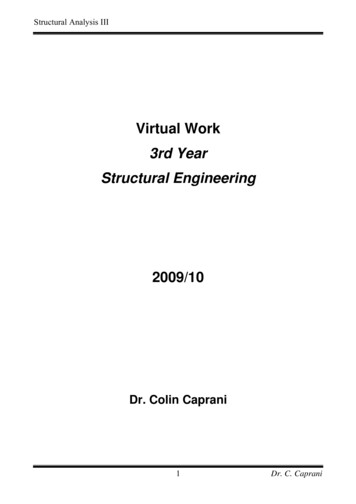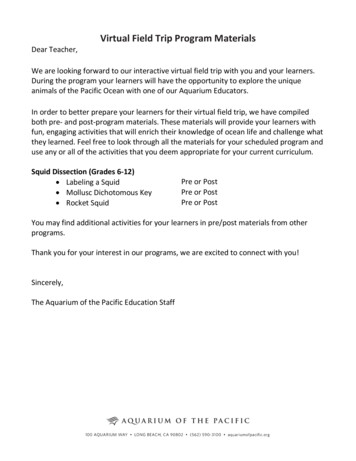
Transcription
Virtual Field Trip Program MaterialsDear Teacher,We are looking forward to our interactive virtual field trip with you and your learners.During the program your learners will have the opportunity to explore the uniqueanimals of the Pacific Ocean with one of our Aquarium Educators.In order to better prepare your learners for their virtual field trip, we have compiledboth pre- and post-program materials. These materials will provide your learners withfun, engaging activities that will enrich their knowledge of ocean life and challenge whatthey learned. Feel free to look through all the materials for your scheduled program anduse any or all of the activities that you deem appropriate for your current curriculum.Squid Dissection (Grades 6-12) Labeling a Squid Mollusc Dichotomous Key Rocket SquidPre or PostPre or PostPre or PostYou may find additional activities for your learners in pre/post materials from otherprograms.Thank you for your interest in our programs, we are excited to connect with you!Sincerely,The Aquarium of the Pacific Education Staff
Teacher ResourcesVocabulary Word BankCephalopod: Group of molluscs whose appendages attach to their head.Mollusc: Invertebrate animals who have an unsegmented, soft body, and may or may not have anexternal shell.Gonads: The reproductive organs responsible for creating sperm or eggs, and producing the sexhormones.Mantle: The body wall that covers the visceral mass and internal organs of a mollusk. In shelledmolluscs it creates the shell.Tentacle: A flexible, mobile, elongated organ present in some species of animals, most of theminvertebrates. In cephalopods tentacles only have suckers at the end of the limb.Arm: Used interchangeably with tentacle, in cephalopods arms contain suckers along most the lengthof the limb, like with an octopus.Siphon: A long tube-like structure that is present in certain aquatic molluscs. Used for a mode of fastswimming (referred to as jet propulsion) as well as the release of waste.Dichotomous key: A key for the identification of organisms based on a series of choices betweenalternative characters.Gastropod: Mollusks (such as snails and slugs) usually with a univalve shell or none and a distinct headbearing sensory organs.Bivalve: Mollusks (such as clams, oysters, or scallops) that have a 2-valved hinged shell, are usuallyfilter feeders, and lack a distinct head.Scaphapod: The tusk-shell or tooth-shell animals, members of a class of shelled marine molluscs.Polyplacophora: The chitons. Chitons are marine molluscs of varying size with oval bodiesTestes: Male gonad that produces sperm cells.Eggs: Female reproductive cell.Activity Notes for TeachersLabeling a SquidFor this activity you can have learners complete this before or after your program with theAquarium. During the dissection, our educator will begin by having the learners make observationsof the outside of a squid, discussing adaptations of the squid, and answering learners’ questions.For the dissection and internal examination our educator will show your learners how to open thesquid and then examine the various organs that are visible. We will also show the comparisonbetween male and female internal anatomy. With time permitting additional dissection activitiescan include extracting the jaw, removing the pen from the squid, removing the lens of the eye, andopening the ink sac.
Answer Key for Labeling a squidExternal AnatomyInternal AnatomyMollusc Dichotomous KeyThis activity can be done before or after your program and will explore specific characteristics of molluscs.Learners must answer the questions in sequence in order to identify each of the types of cephalopods.Questions are in a yes/no design with each question either progressing the process of elimination or resultingin the unknown animal’s identity.Rocket SquidThis is an optional lab activity that can be done before or after your program to show students how rocketpropulsion works in squid and octopus. Cephalopods all have siphons, certain species can use it to propelthemselves faster than others, but they all use them as part of their motion to escape predators.
Labeling a SquidUsing the diagram provided, label the external anatomy of a squid.External Anatomy
Labeling a SquidUsing the diagram provided, label the external anatomy of a squid.Internal Anatomy of a Male Squid
Mollusc Dichotomous KeyScientists often use dichotomous keys to identifyand classify different types of animals.1. Use the dichotomous key below to identify theanimal to the right and the ones on the followingpages.2. Select one animal at a time and answer each ofthe “questions” below as you observe each animal.1A. No shell apparent1B. Hard shellgo to 2go to 52A. Arms or tentacles present2B. No arms or tentacles presentgo to 3Sea Slug (gastropod)3A. 8 arms and 2 tentacles present3B. 8 arms and no tentacles presentgo to 4octopus (cephalopod)4A. Long, finger-like mantle4B. Rounded mantlesquid (cephalopod)cuttlefish (cephalopod)5A. Single shell5B. Shell has multiple partsgo to 6go to 86A. Single shell spiral shape6B. Single shell is not spiraledsnail (gastropod)go to 77A. Shell is concave7B. Shell is elongated and taperedabalone (gastropod)tusk shell (scaphopod)8A. Two distinct shells, hinged on one side8B. Multiple platesclam (bivalve)chiton (polyplacophora)
Mollusc Dichotomous Key1.Unknown Animals to Identify2.3.4.5.6.7.8.
Rocket SquidOBJECTIVES Learners will conceptualize mechanics of jet propulsion by using cephalopods as a natural model. Learners will understand structure and function of a living organism and how specific adaptations enable itssurvival. Learners will engineer a model to demonstrate Newton’s Third Law of Motion (for every motion there is anequal and opposite reaction).BACKGROUNDCephalopods are one of the few animals that rely on jet propulsion as their primary method of locomotion. Theseinvertebrates alternate between relaxing and contracting muscles along and around their body to allow water to enterthe mantle, their large body cavity. As water enters the mantle, it passes over two sets of gills to help the cephalopodsextract oxygen. As the mantle muscles contract, water is forced through the siphon, a small muscular funnel under thehead and often behind the eyes. This physical process is remarkably energy-efficient and helps them retain a placehigher in the food web and predator and prey. In this activity, learners will experiment with Newton’s Third Law ofMotion and engineer a model that solves a problem.PREP TIME: 5 minutesCLASS TIME: 20 minutesMATERIALS String or fishing line Multicolored balloons Tape Straws Binder clips/Paperclips/other clip MarkersPROCEDURE1. Have learners pair up. Each pair receives one balloon, one straw, and two pieces of tape.2. Inflate the balloon, then pinch off the bottom of the balloon with a binder clip (don’t tie off the balloon!)a. If possible, you can decorate the balloon’s siphon end to look like it has tentacles and arms3. Tape the straw to the back of the balloon. Learners can cut the straw and tape the two pieces to the balloon orleave it as one piece-designers choice.4. Instructor: Clear space in the classroom so that learners can line up on either end of the room-one learner willbe holding their squid balloon. Cut the fishing line or string the length between learners. Give each pair a string.Instruct them to hold the string taught or as tight as possible.a. The learner with the balloon will feed the fishing line or string into the straw and then remove thebinder clip and let their balloon go when ready.b. Pairs can go one at a time or all together to ‘race’ each other.5. Sample questions to guide a post experiment discussion:a. Do you think changing the balloon size would affect how fast it travels?b. Do you think changing straw size would affect how fast the balloon travels?c. Do you think adding accessories like arms or tentacles impact how fast the squid swam?
Squid Dissection (Grades 6-12) Pre or Post Labeling a Squid . filter feeders, and lack a distinct head. Scaphapod: The tusk-shell or tooth-shell animals, members of a class of shelled marine molluscs. . higher in the food web and predator and prey. In this activity, learners will experiment with Newton's Third Law of .
